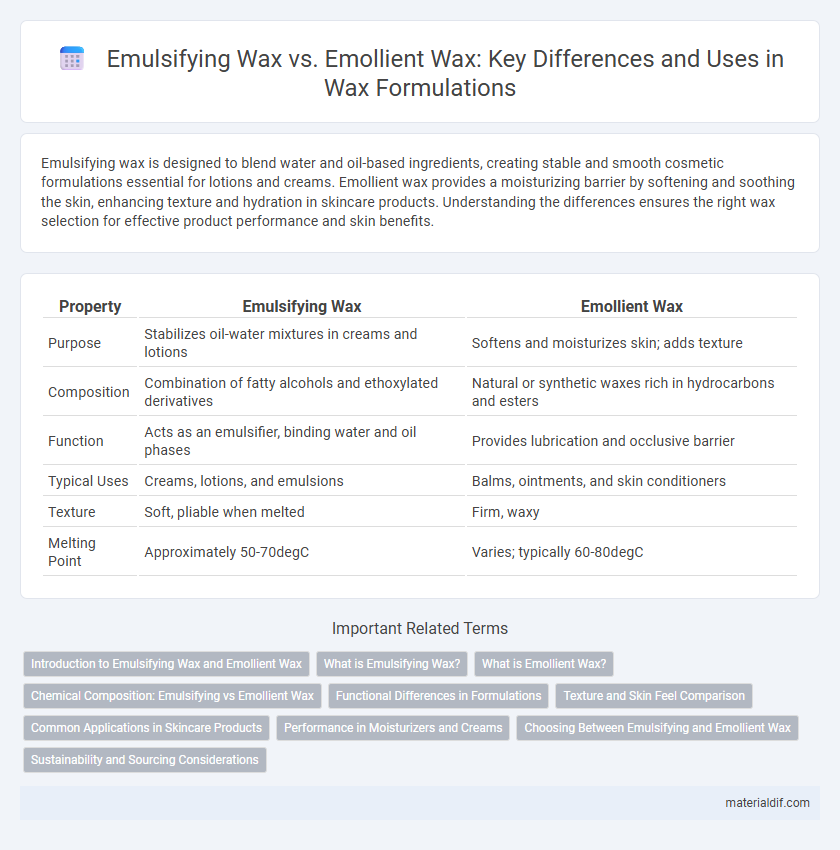Emulsifying wax is designed to blend water and oil-based ingredients, creating stable and smooth cosmetic formulations essential for lotions and creams. Emollient wax provides a moisturizing barrier by softening and soothing the skin, enhancing texture and hydration in skincare products. Understanding the differences ensures the right wax selection for effective product performance and skin benefits.
Table of Comparison
| Property | Emulsifying Wax | Emollient Wax |
|---|---|---|
| Purpose | Stabilizes oil-water mixtures in creams and lotions | Softens and moisturizes skin; adds texture |
| Composition | Combination of fatty alcohols and ethoxylated derivatives | Natural or synthetic waxes rich in hydrocarbons and esters |
| Function | Acts as an emulsifier, binding water and oil phases | Provides lubrication and occlusive barrier |
| Typical Uses | Creams, lotions, and emulsions | Balms, ointments, and skin conditioners |
| Texture | Soft, pliable when melted | Firm, waxy |
| Melting Point | Approximately 50-70degC | Varies; typically 60-80degC |
Introduction to Emulsifying Wax and Emollient Wax
Emulsifying wax is a key ingredient in skincare formulations that combines oil and water phases, creating stable creams and lotions with a smooth texture. Emollient wax, on the other hand, primarily acts as a moisturizing agent, forming a protective barrier on the skin to prevent dryness and improve softness. Understanding the functional differences between emulsifying wax and emollient wax is essential for developing effective cosmetic and personal care products.
What is Emulsifying Wax?
Emulsifying wax is a versatile cosmetic ingredient designed to blend oil and water phases into stable, homogeneous mixtures, commonly used in creams and lotions. It contains surfactants that reduce surface tension between oil and water, enabling emulsification and improving product texture and consistency. Unlike emollient wax, which primarily provides moisturizing and protective properties, emulsifying wax plays a crucial role in forming and maintaining the emulsion's stability.
What is Emollient Wax?
Emollient wax is a type of wax derived from natural oils and fats, designed to provide moisturizing and soothing properties in skincare formulations. Unlike emulsifying wax, which primarily acts as a surfactant to blend oil and water phases, emollient wax enhances skin hydration by forming a protective barrier that helps retain moisture. Commonly used in creams and lotions, emollient wax improves texture and skin feel while delivering nourishment and softness.
Chemical Composition: Emulsifying vs Emollient Wax
Emulsifying wax is primarily composed of fatty alcohols like cetyl and stearyl alcohols combined with emulsifiers such as polysorbates, enabling effective blending of oil and water phases in cosmetic formulations. Emollient wax, on the other hand, consists mainly of natural waxes such as beeswax or plant-based waxes rich in hydrocarbons and esters, providing moisturizing and skin-softening properties without emulsifying capabilities. The distinct chemical composition of emulsifying wax facilitates stable emulsion formation, whereas emollient wax contributes texture and hydration but lacks emulsification activity.
Functional Differences in Formulations
Emulsifying wax acts as a key surfactant that stabilizes oil and water mixtures in formulations, ensuring consistent texture and preventing separation. Emollient wax primarily provides moisturizing and barrier-enhancing properties, contributing to the skin's softness and protection without influencing the emulsion stability. Understanding these functional differences helps formulators select the appropriate wax for targeted product performance, such as improving texture or enhancing skin hydration.
Texture and Skin Feel Comparison
Emulsifying wax creates a smooth, creamy texture that blends water and oil phases for a stable, lightweight formula, enhancing hydration without greasiness. Emollient wax offers a richer, occlusive feel, providing a thicker, protective barrier ideal for dry or sensitive skin types. The skin feel of emulsifying wax is silky and non-greasy, while emollient wax imparts a more substantial, moisturizing finish.
Common Applications in Skincare Products
Emulsifying wax is widely used in skincare products to blend oil and water phases, creating stable creams and lotions for moisturizing and hydrating the skin. Emollient wax, on the other hand, is primarily utilized to provide a protective barrier and enhance skin softness by locking in moisture in products like balms and ointments. Both waxes play crucial roles in formulating effective skincare, with emulsifying wax ensuring texture and stability, while emollient wax delivers hydration and skin conditioning benefits.
Performance in Moisturizers and Creams
Emulsifying wax excels in enhancing the texture and stability of moisturizers and creams, creating smooth, homogeneous blends by effectively binding oil and water components. Emollient wax primarily boosts hydration and skin barrier repair by forming a protective, occlusive layer that locks in moisture. Choosing between emulsifying and emollient wax impacts product performance, with emulsifying wax ensuring consistent cream consistency while emollient wax promotes longer-lasting moisturization.
Choosing Between Emulsifying and Emollient Wax
Choosing between emulsifying wax and emollient wax depends on the formulation goals and skin benefits desired. Emulsifying wax is ideal for creating stable water-in-oil or oil-in-water emulsions, enhancing texture and consistency in creams and lotions. Emollient wax provides moisturizing and skin-softening properties, making it suitable for products targeting hydration and barrier repair.
Sustainability and Sourcing Considerations
Emulsifying wax is typically derived from plant-based oils or synthetic sources, offering better sustainability due to renewable raw materials and biodegradability, whereas emollient wax often comes from petroleum-based or animal origins, posing larger environmental impact concerns. Sustainable sourcing of emulsifying wax includes certification schemes like RSPO for palm oil derivatives, minimizing deforestation and habitat loss. Emollient wax sourcing requires stricter scrutiny to avoid overexploitation and ensure ethical supply chains, influencing the overall eco-friendliness of personal care formulations.
Emulsifying wax vs Emollient wax Infographic

 materialdif.com
materialdif.com